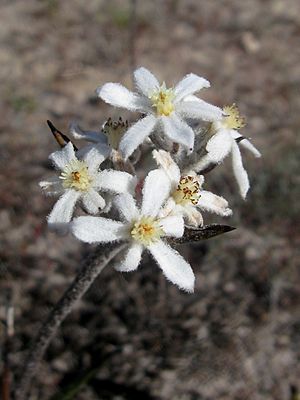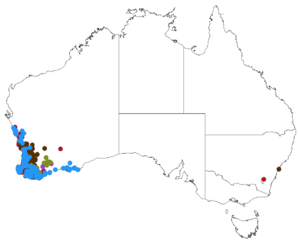Tribonanthes facts for kids
Quick facts for kids Tribonanthes |
|
|---|---|
 |
|
| Scientific classification |
|
| Kingdom: | Plantae |
| Clade: | Tracheophytes |
| Clade: | Angiosperms |
| Clade: | Monocots |
| Clade: | Commelinids |
| Order: | Commelinales |
| Family: | Haemodoraceae |
| Subfamily: | Conostylidoideae |
| Genus: | Tribonanthes Endl. |
| Type species | |
| Tribonanthes australis Endl.
|
|
 |
|
| Occurrence data from AVH | |
Tribonanthes is a special group of plants that only grow in Western Australia. These plants are part of the Haemodoraceae family, which is sometimes called the bloodwort family. This means they are endemic to Western Australia, which means they are found naturally nowhere else in the world!
Contents
About Tribonanthes Plants
Tribonanthes plants are known for their unique features. They are a genus of plants, which is a scientific way to group together different types of plants that are very similar. Think of it like a family name for plants.
Where Tribonanthes Grow
These plants are found only in the southwestern part of Western Australia. This area has a special climate that helps these plants grow. They often grow in sandy soils or areas that might be wet at certain times of the year. The map in the infobox shows exactly where they have been found.
Different Kinds of Tribonanthes
There are several different types, or species, of Tribonanthes plants. Each species has its own unique look, but they all share common features that place them in the Tribonanthes genus.
Here are some of the known species:
- Tribonanthes australis Endl. – This is the main type of Tribonanthes that scientists first studied.
- Tribonanthes brachypetala Lindl.
- Tribonanthes longipetala Lindl.
- Tribonanthes minor M.Lyons & Keighery
- Tribonanthes purpurea T.D.Macfarl. & Hopper
- Tribonanthes sp. Lake Muir (G.J. Keighery & N. Gibson 2134) – This one is named after the place it was found, Lake Muir.
- Tribonanthes violacea Endl.
How Scientists Study Them
Scientists like Stephan Endlicher and others have studied and named these plants. When you see names like "Endl." or "Lindl." after a plant's name, it tells you which scientist first described and named that particular species. This helps everyone know exactly which plant they are talking about.
See also
 In Spanish: Tribonanthes para niños
In Spanish: Tribonanthes para niños

